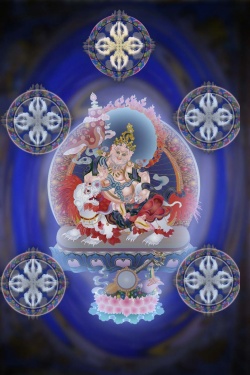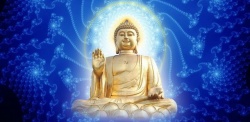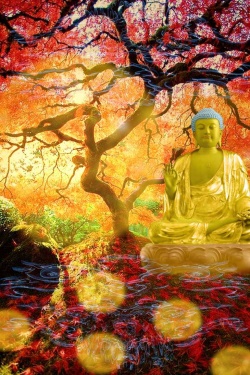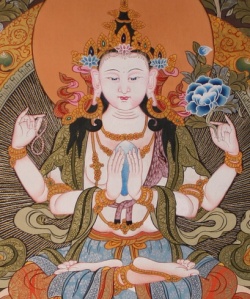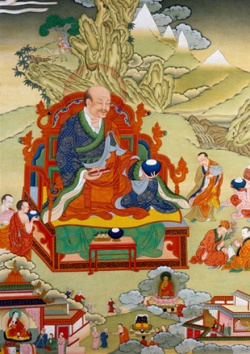Symbols in Theravāda Buddhist Meditation (Bhāvanā) by Chand R. Sirimanne
Symbols in Theravāda Buddhist Meditation (Bhāvanā)
By
Chand R. Sirimanne
PhD Candidate
University of Sydney
From the earliest days of evolution symbols have played a crucial role in human development, the greatest symbolic system of representation being the growth of language. Symbols serve as the ‘shorthand’ of the mind – particularly in the hidden part of it for which Buddhism has a number of terms – none of which is identical to the Subconscious or Unconscious in Western psychology. This paper focuses on the symbols used in the practice of Bhāvanā in Theravāda Buddhism. ‘Bhāvanā’ is variously translated as mental development, the cultivation of the mind, contemplation, reflection and meditation. The Pāli term carries with it much more complex nuances than any single one of these as Bhāvanā is inextricably interwoven with the Buddhist soteriological path to liberation. Thus, it is important to note that in Buddhism meditation is inseparable from its ethical and doctrinal frameworks, and every subject, object and technique in the forty meditative practices outlined in the Pāli Canon (Tipitaka) and the Commentaries has a strong moral foundation focusing on the purification of the mind with its ultimate goal as Enlightenment. Although the acquisition of various special powers are mentioned in relation to some practices, it is discouraged to focus on these, and the scriptures specifically mention the dangers in becoming preoccupied with these as it results in getting side-tracked on the Path to Enlightenment, and even cause harm to oneself and others.
The interest in Buddhism and its meditative techniques has grown exponentially in the West in general and in Australia over the past few decades. Nowhere is this interest stronger than in the field of psychology and psychotherapeutic applications to combat psychopathologies and to increase wellbeing, and meditation is now being used even in such unexpected sectors as business, military and sports. Finding a solution to human suffering is essentially the interface between Buddhist meditation and Western psychology, though the approach and ultimate goals are different. It is Mindfulness meditation first and foremost and Loving-kindness meditation to a much less extent that is the overwhelming focus of interest although Theravāda Buddhism alone provides so many others that can be beneficial. However, it is still a new phenomenon in the West, and this immense interest has revitalized Buddhism in general, and particularly Buddhist meditative practice, which has largely been ignored among the lay communities of the traditional Buddhist countries as the preserve of monks and a small minority of committed individuals.
The forty subjects of meditation are outlined and explored in numerous ways in the Pāli Canon (Tipitaka) – the Sutta Pitaka presenting the information to an eclectic audience with varying intellectual capacity using conventional terms, and Abhidhamma Pitaka where mind, matter and all phenomena are analysed in minute and highly technical detail and are discussed only in terms of the ultimate reality. It is, however, Visuddhimagga, the great commentarial text compiled by Buddhaghosa Thera that is widely considered to be the most detailed and comprehensive source regarding the objects/subjects and techniques used in meditation.
The forty meditative subjects in Theravāda Buddhism are as follows:
- 10 Kasina Meditation exercises using round devices or objects representing 1. Earth, 2.Water 3. Fire 4. Air 5.Blue 6. Yellow 7. Red 8. White 9. Light 10. Space
- 10 Asubha Meditation exercises (Loathsome or impure objects) using 1. A swollen corpse 2. A discoloured corpse 3. A festering corpse 4. A fissured corpse 5. A mangled corpse 6. A dismembered corpse 7. A cut and dismembered corpse 8. A bleeding corpse 9. A worm-infested corpse 10. A skeleton
- 10 Anussati (Recollections/Contemplations) of 1. The Buddha 2. The Dhamma (Law) 3. The Noble Monastic Order 4. Morality 5. Liberality 6. Heavenly Beings 7. Death 8. The Body 9. The Breath 10. Peace
- 4 Appamañña/Brahma Vihāra (Unlimited States) exercises on 1. Mettā (Loving-kindness) 2. Karunā (Compassion) 3. Mudithā (Altruistic Joy) 4. Upekkhā (Equanimity)
- 4 Arūpayātana (Immaterial or Formless Spheres) meditations on 1. Unbounded Space 2. Unbounded Consciousness 3. Nothingness 4. Neither-Perception-nor-Non-Perception
- 1 Ᾱhāre-patikkūlasaññā (Perception of the Loathsomeness of Food) meditation
- 1 Catu-dhātu-Vavatthāna (Analysis of the 4 Elements) meditation on the primary elements of Earth, Water, Fire and Air
These forty subjects of meditation can be broadly categorized into two methods: Samatha (Concentration) and Vipassanā (Insight). These are not separate paths but two sides of the same coin – interdependent and supporting each other in stilling the mind, ridding it of defilements and increasing its wholesomeness, strength, clarity and wisdom. The doctrine of Anattā (Non-Self) being at the very heart of Buddhism, every meditative practice has the ultimate goal of gradually dismantling the personality view, the core delusion, which is fundamentally responsible for all emotional barriers and suffering. Meditation, therefore, aims to increase awareness and expand the mind, increasing compassion and acceptance, weakening and finally breaking down the ego/self. The symbolism of both the subjects and objects of meditation as well as the techniques all work towards this end although each has immediate and secondary goals as well. Every symbolic representation used in the practices, therefore, such as the breath, body, feelings, mind objects, a single colour, the elements, body parts, death, disintegration of the body, and the incitement of repulsion towards the body and food, boundless loving-kindness towards everyone are all designed for a specific purpose initially and then ultimately to pave the way to see the fundamental reality of all existence - Impermanence (anicca) Unsatisfactoriness (dukkha) and Non-Self (anattā) with the final goal of reaching the unconditioned limitlessness and emptiness of the only perfect state - Nibbhāna.
In Mindfulness of Breath meditation, which is the most widely known and practiced of all the subjects today, the focus is on the breath – inhalation, exhalation, its quality (whether gross or subtle, short or long etc.). It is immensely valued in the Pāli Canon too as it gives rise to both Concentration and Insight and is capable of inducing all Four Jhānic (Absorptions or deep states of consciousness) states. The breath here is the symbol of life and breathing being the most fundamental task of the body that is normally done unconsciously. The immense value in the awareness and observation of the breath lies in the fact that it opens the doorway into the unconscious processes of the mind and reflects the experiences of the mind-body (nāma-rūpa) complex so closely and intensely –becoming laboured and quickening when under stress or due to anger, fear etc. and slowing and becoming subtle when calm and relaxed. The breath therefore is a mirror of what one feels both mentally and physically. It is also symbolic of the utter fragility of life as this particular life will cease if the next inhalation fails to arrive, and with this realization of the vulnerability of the body other insights begin to arise such as that other sensations of the body, feelings and mental objects too are transient and essentially unsatisfactory. The mind, more than anything else, demonstrates the three characteristics of Samsāra or all existence once the ‘observer’ replaces the ‘doer’ in the processes of the mind. As insight grows to expose the nature of the mind, with its ever-changing thoughts, textures and hues, one begins to question who the ‘owner’ is. Over time, the observation of the breath leads to the third and most complex insight of all – that there is no abiding, concrete personality or self in either the body or the mind. This is the concept of Anattā, at the very core of Buddhism, and the Breath is ultimately a symbol of this emptiness as well – demonstrating that one is a mere process rather than a person. Of the 10 Contemplations (Anusati) Mindfulness of the Breath is the only one that produces all 4 Jhānas (Absorptions).
Another of the 10 Contemplations is that of the Contemplation of the Body, which is similar and also linked to another one of the meditative practices, Analysis of the 4 Elements (Catudhātu-Vavatthāna: Earth, Water, Fire and Air. Both involve the analysis and breaking down of the body into its core components – in the former into its 32 parts with a focus on its repulsive nature (the body as a collection of blood, bones, tissues and various impure matter that gives the illusion of a concrete, attractive and lasting individual), and in the latter every component of the body categorized into the 4 primary elements (mahā bhūta) of earth, water, fire and air with a specific focus of its lack of any individuality but through their interactive operations create something that trick the mind into thinking of the body as a person . In both methods, however, the body is used as a symbol in which to extrapolate the universal truths that apply to oneself, to other human beings, to all other living beings and then finally to all matter and phenomena in the cosmos.
Another meditative practice takes the Perception of the Loathsomeness of Food (Ᾱhāre- patikkūlasaññā) as its object. It too has close links with the above mentioned two as it focuses on the most important functions of the body next to breathing, which is all the different facets of our dealings with food, and centering particularly on the repulsive nature of the whole process starting with the search for food to the last phase of elimination of its waste product. Given that food is the second most vital requirement for survival of all beings with corporality, our occupation with its production and procurement takes up an enormous percentage of our mental and physical energies, providing a fertile breeding ground for all the major defilements of greed, ill-will, delusion and their manifold manifestations. At a fundamental level all wars and conflicts arise over resources, and the attachment and craving for food grows far beyond the actual nutritional needs required for survival. The first and foremost of the 5 Hindrances that prevent any meditative practice to deepen is Sensory Desire (kāmachanda), and food arouse almost every sensory organ in the course of its procurement, preparation, partaking and enjoyment, controlling so many aspects of the mind and body. The objective of this meditation is therefore to lesson gradually the obsessive and excessive nature of the attitude towards food through contemplating the whole process to discern its gross and even revolting nature – the disgusting way it is consumed and then its passage through the various processing organs of the body and finally the exit from the body as filth that even the owner finds repellent – all in the course of several hours. Thus, the food here is symbolic of materiality that beings find attractive for a brief moment, just as the body too becomes a thing of suffering, decay and death. At a deeper level it once more illustrates the 3 characteristics of existence – Impermanence, Unsatisfactoriness and Non-Self.
The Contemplation of Death (Maranāssati), another of the 10 Anusattis, once more centres on the body, but with the focus on its break up or death. The meditator is asked to contemplate the various aspects of death – its inevitability, the countless ways in which it comes, its unpredictability as to cause, manner, time or place and the brevity and fragility of life. In a Western context the thought of death is often avoided and thinking of it perceived as morbid, depressing and traumatic. However, in Buddhism, as in this Contemplation, it is seen as something with great potential for liberation – penetrating the veil of the delusion of permanence and satisfactoriness and ultimately a concrete and abiding self. The concept of death, thus becomes symbolic of transience in particular applied to oneself, others and then broadly to everything in existence. It also serves as a ‘wake-up call’ to lead an ethical life and to cultivate the mind as the cycle of rebirth continues without ultimate liberation.
The 10 meditations on the Loathsome Objects (Asubha) is a natural progression from the theme of the breath, body and food to that of a corpse. In Buddha’s time actual corpses and skeletons in various stages of decomposition were used by some monks as meditative objects, though this practice comes with many warnings with regard to both physical and mental dangers even in the Canonical and Commentarial texts. Here, the meditative objects are corpses of people who had died or been killed in various ways and in various stages of decomposition – swollen, discoloured, festering, fissured, mangled, dismembered, bleeding, maggot-ridden, and finally a skeleton. This disintegration of a thing (body) that is perceived as such an integral part of one’s identity, a source of so much craving and attachment both to one’s own and others’ bodies and excitation of the senses begins to reveal its repulsive, gruesome and impersonal nature. Once more, the specific objective is to destroy the illusion of the body as being something attractive, enjoyable and lasting, but the 10 objects and the disintegration process are ultimately symbolic of the process that applies to oneself and all matter that exists. These ten meditative practices can produce the First Jhāna (Absorption).
The 10 meditations called the Kasina Bhāvanā using meditative devices that represent Earth, Water, Fire, Air, (the colours of) Blue, Yellow, Red and White, Light and Space are mostly ignored these days though they used to be practiced in ancient times as powerful meditations producing deep concentration (Samādhi) and capable of giving rise to all 4 Jhānas (Absorptions). These devices can be either made or what is found in nature, and the most extensive instructions for all stages of making the devices and the practice as well as the benefits are to be found in the Visuddhimagga. Essentially the practice involves concentrating the mind on the object so deeply that it suppresses the 5 Hindrances and give rise first to a Learning Sign (a replica of the object) in the mind and then to the Counterpart Sign (an abstract representation of the object generated by the mind) which raises the consciousness to deep states of concentration and ultimately to all 4 Jhānic levels. As the Patibhāga Nimitta or the Counterpart Sign becomes well-established in the mind, it is then recommended that the sign be expanded gradually to finally encompass the whole world and beyond. The Counterpart Sign could thus be said to be symbolic of the mind that is temporarily free of normal cognitive processes, the defilements that normally block higher states of concentration and the constraints of the controlling personality view.
The 4 meditations on the Immaterial Spheres (Arūpayātana) consist of Unbounded Space, Unbounded Consciousness, Nothingness, Neither-Perception-Nor-Non-Perception is the next step in the development of Samādhi meditation after the attainment of the 4 Rūpa Jhānas (the first 4 Absorptions of the Fine Material Sphere). These four practices are thus closely associated with the next 4 states of deep concentration called the 4 Arūpa Jhānas. Whereas the 4 Rūpa Jhānas are achieved through meditation initially on a visible object (such as the Kasina or Asubha etc.) or concept (Breath, Death etc.) and then the conceptual Sign (nimitta) derived from them, the Arūpa states are attained through the removal of the object (both real and conceptual). These are known as Arūpa or Formless as they are beyond all cognition and form perceptions. They symbolize the highest states of consciousness the mind is capable of in its journey towards Nibbhāna, jettisoning last of the āsavas (cankers), all perceptions and finally even consciousness itself, penetrating the core reality of all existence as empty – Suññatā (void or emptiness) at the heart of all conditioned matter and phenomena. Thus, these four meditative objects too are symbolic of the mind as it becomes ever more purified, deeply refined, limitless, and finally empty even of itself as a prelude to the highest levels of attainment on the Noble Path leading to Nibbhāna, the only Unconditioned state.
The 4 meditative practices of the Unlimited States (Appamañña) consist of Mettā (Loving-Kindness), Karunā (Compassion), Mudithā (Altruistic Joy) and Upekkhā (Equanimity) that use symbolic representations of three levels of emotions regarding various people and other sentient beings (loved, neutral and disliked persons) in order to gradually establish these four concepts and related emotions in the mind expanding it beyond the narrow constraints of the self. Theravāda Buddhism in particular has often been criticized for being pessimistic and even nihilistic in its attitudes and doctrine. However, these four Unlimited States play a crucial role in its overall belief system – from its core moral requirements of the Five Precepts, the 227 rules of the Code of Discipline for Monastics (Pātimokkha) to its system of mental cultivation are all geared towards Ahimsa (harmlessness) and the active caring for others, and these four states imbue the whole Buddhist ethico-psychological framework with a luminous benevolence, and are designed not only to remove defilements, heal psychopathologies but also help advance on the Path.
These practices involve the replication of the symbolic and idealistic love, compassion, joy and acceptance that “a mother feels for her only child” (Karaniyametta Sutta) towards oneself, family, friends, strangers, even enemies, all other species and finally all sentient beings in the Cosmos, which in Buddhist cosmology consists of 31 planes of existence. The enormous transformative and healing energy of the positive emotions have now been recognized in Western psychology as witnessed by the rise of the Positive Psychology movement. These emotions are not easy to foster naturally except towards those close to us but over time the practice helps to break down the barriers through weakening of the personality view, craving, ill-will and delusions associated with it. What begins as a somewhat artificial exercise or a symbolic gesture gradually becomes the texture of the mind as the positive thoughts are fostered to become habitual over time - an ever expanding and inclusive circle of positivity.
The 10 Contemplations (Anussati), of which those on Death, the Body, the Breath have already been discussed above, also contain meditations on the Buddha, Dhamma, Sangha, Morality, Liberality, Heavenly Beings and Peace, the symbolic nature of which are obvious – perfection, wholesomeness and inspirational. These 7 Contemplations do not lead to the Jhānic states but only to Access Concentration (Upacāra Samādhi) that is preliminary to the First Jhāna. However, they are recommended practices for calming the mind, suppressing the hindrances and gaining happiness and confidence. The Contemplations on the Buddha, Dhamma and Sangha especially give rise to gratitude and confidence in following the Path, and the rest engender zest and confidence in one’s own virtue or that of others, including the deities, whom one wishes to emulate. All in all the Contemplations create positive states of mind banishing the negatives and creating tranquillity.
It should be noted that the Buddha recommended different meditative subjects to suit various personality types – very much in tune with contemporary learner-centred and individually-tailored training methods. Visuddhimagga describes 6 types of temperaments citing the Canon as people who are: 1. Disposed to hatred and ill-will 2. Of a lustful nature 3. Imbued with faith 4. Prone to intellectuality 5. Prone to delusion, and 6. Prone to agitation. The 4 Appamāññas and the 4 Colour Kasinas are recommended for Type 1. The 10 Asubhas, the 32 parts of the Body meditation and the Breath are recommended for Type 2. For Type 3 the first 6 Contemplations (on the Buddha, Dhamma, Sangha, Morality, Liberality and Heavenly Beings) are advocated, and for Type 4 the Contemplation on Death, Perception of the Loathsomeness of Food and the Analysis of the 4 Elements are advocated. It is said that the remaining meditative subjects are suitable for all cognitive dispositions. The immediate goals of each meditative practice becomes clear when considering this targeting of personality types, while the wider and ultimate goal of penetrating the veil of delusion and understanding reality remains the same for all practices.
The body and its functions and states as discussed is the most important and predominant symbol used in the meditation practices in Theravāda Buddhism. There are several places in the Sutta Pitaka where the Buddha is quoted:
- “It is in this fathom-long body, friend, with its consciousness and mind, I declare, that the world lies, together with its origin, cessation and the path leading to its cessation.” (S.i.62; A.ii.48)
There is no duality of a mind and a body in Buddhism but it is a mind-body complex (nāma-rūpa) working in tandem, and the concept of an identity is the central delusion as there is no concrete self, identity or eternal soul in anyone or anything, which is the unique concept at the very beating heart of Buddhism, and it is this fundamental delusion that traps all beings in the flux of life. The stream of consciousness that flows from life to life is in fact a process rather than an entity, and meditation strives to eliminate the Five Hindrances, all defilements and finally destroy the personality view ending the cycle of birth and death or Dependent Origination (paticca samuppāda). In order to achieve this the mind first needs to achieve tranquillity and become still through focusing on one object for some time rather than the habitual constant adverting to a multitude of discursive and ruminating thoughts that are mostly judgemental and analytical. Meditation involves focusing the mind in a unified manner on one object, gaining insight into its true nature and then applying that knowledge gained to the whole of the cosmos and existence.
References
- 1.Buddhaghosa, Bhadantacariya. Visuddhimagga. (The Path of Purification. Translated from the Pāli by Bhikkhu Nanamoli. 3rd online ed. 2011. Buddhist Publication Society. Sri Lanka.
- 2. Brahm, Ajahn. 2006. Mindfulness, Bliss, and Beyond. A Meditator’s Handbook. Wisdom Publications. Inc. MA, USA.
- 3. Karaniya Metta Sutta. Sn. 1.8 & Khp 9)
- 4. Mahasi Sayadaw. 1971. Practical Insight Meditation. Basic and Progressive Stages. (Translated from the Burmese by U Pe Thin & Myanaung U Tin). Buddhist Publication Society: Kandy, Sri Lanka.
- 5. Maithrimurthi, M. 1999. Wohlwollen, Mitleid, Freude und Gleichmut: eine ideengeschlichtliche Untersuchung der vier apramanas in der buddhistischen Ethik und Spiritualität von den Anfängen bis hin zum frűhen Yogacara. (Alt- und Neu-Indische Studien, 50.) Stuttgart: Franz Steiner Verlag.
- 6. Narada Thera. 1988 (first pub. 1942). The Buddha and His Teachings. Buddhist Missionary Society: Malaysia.
- 7. Nyanaponika Thera. 1962. The Heart of Buddhist Meditation. A handbook of mental training based on the Buddha’s way of mindfulness. Buddhist Publication Society: Kandy, Sri Lanka.
- 8. Nyanaponika Thera. 1986. The Vision of Dhamma. Buddhist Writings of Nyanaponika Thera. Buddhist Publication Society: Kandy, Sri Lanka.
- 9. Nyanatiloka Mahathera. 1980. Buddhist Dictionary. Manual of Buddhist Terms and Doctrines. Buddhist Publication Society. Kandy, Sri Lanka.
- 10. Vajiranana, Paravahera Mahathera. 1975. Buddhist Meditation. In Theory and Practice. 2nd ed. Buddhist Missionary Society. Kuala Lumpur, Malaysia.
- 11. Shapiro, Deane H. & Walsh, Roger N. (eds). 1984. Meditation: Classic and Contemporary Perspectives. Aldine Publishing Company, NY.
- 12. Snyder, C.R. & Lopez, Shane J. (eds). 2009. Oxford Handbook of Positive Psychology. (2nd eds). Oxford University Press.
Source
Buddhism And Australia Conference 2015 http://buddhismandaustralia.com/
